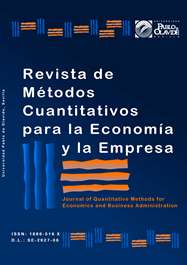Reconciliations and bid strategies in the Colombian wholesale electricity market
DOI:
https://doi.org/10.46661/revmetodoscuanteconempresa.6058Keywords:
electricity market, spot market, bid strategies, reconciliationsAbstract
In this paper, we study the relationship between reconciliations in the Colombian electricity market and the bid prices by firms on the spot market. In this work, we propose a model of behavior of the firm to elaborate theoretical predictions about the relationship between the reconciliations and the bid prices. Subsequently, we developed an empirical strategy to test the predictions of our model. We find that when firms expect their units to have negative reconciliations the next day, they tend to reduce the bid prices for their units. To positive reconciliations, there is no evidence of any relationship.
Downloads
References
Balat, J., Carranza-Romero, J.E.R., & Martin, J.D. (2015). Dynamic and strategic behavior in hydropower-dominated electricity markets: empirical evidence for Colombia. Borradores de Economía, 886, 1-56. https://doi.org/10.32468/be.886
Borenstein, S., & Bushnell, J. (1999). An empirical analysis of the potential for market power in California's electricity industry. Journal of Industrial Economic, 47(3), 285-323. https://doi.org/10.1111/1467-6451.00102
Bushnell, J.B., Mansur, E.T., & Saravia, C. (2008). Vertical arrangements, market structure, and competition: An analysis of restructured us electricity markets. American Economic Review, 98(1), 237-266. https://doi.org/10.1257/aer.98.1.237
Camelo, S., Papavasiliou, A., de Castro, L., Riascos, A., & Oren, S. (2018). A structural model to evaluate the transition from self-commitment to centralized unit commitment. Energy Economics, 75, 560-572. https://doi.org/10.1016/j.eneco.2018.09.009
Ciarreta, A., Espinosa, M.P. (2010). Market power in the Spanish electricity auction. Journal of Regulatory Economics, 37, 42-69. https://doi.org/10.1007/s11149-009-9102-7
Crawford, G.S., Crespo, J., & Tauchen, H. (2007). Bidding asymmetries in multi-unit auctions: Implications if bid function equilibria in the British spot market for electricity. International Journal of Industrial Organization, 25, 1233-1268. https://doi.org/10.1016/j.ijindorg.2006.10.001
CREG (2001). Resolución 034. Comisión de Regulación de Energía y Gas. Por la cual se dictan normas sobre funcionamiento del Mercado Mayorista de Energía.
CREG (2004). Resolución 004. Comisión de Regulación de Energía y Gas. Por la cual se modifica la Resolución CREG-017 de 2002, sobre mecanismos de verificación de la disponibilidad declarada de las plantas o unidades de generación.
CREG (2010). Documento creg-060. Metodología para el cálculo del precio de reconciliación negativa.
CREG (2018). Estudio para la modernización del despacho y el mercado spot de energía eléctrica - despacho vinculante y mercados intradiarios. http://apolo.creg.gov.co/Publicac.nsf/52188526a7290f8505256eee0072eba7/81bf4938da2e76b805258352007a69c7/$FILE/Circular092-2018%20Anexo2.pdf
Gans, J.S., & Wolak, F.A. (2008). A comparison of ex ante versus ex post vertical market power: Evidence from the electricity supply industry. SSRN Working Paper. https://doi.org/10.2139/ssrn.1288245
Green, R.J., & Newbery, D.M. (1992). Competition in the British electricity spot market. Journal of Political Economy, 100(5), 929-953. https://doi.org/10.1086/261846
Greene, W.H. (2012). Econometric analysis, 7th ed. New Jersey: Prentice Hall.
Hortacsu, A., & Puller, S.L. (2008). Understanding strategic bidding in multi-unit auctions: A case study of the Texas electricity spot market. RAND Journal of Economics, 39(1), 86-114. https://doi.org/10.1111/j.0741-6261.2008.00005.x
Mastropietro, P., Rodilla, P., Rangel, L.E., & Batlle, C. (2020). Reforming the Colombian electricity market for an efficient integration of renewables: A proposal. Energy Policy, 139, 111346. https://doi.org/10.1016/j.enpol.2020.111346
Perez, A., & García-Rendón, J.J. (2020). Integration of non-conventional renewable energy and spot price of electricity: A counterfactual analysis for Colombia. Renewable Energy, 167, 146-161. https://doi.org/10.1016/j.renene.2020.11.067
Reguant, M. (2014). Complementary bidding mechanisms and startup costs in electricity markets. The Review of Economic Studies, 81(4), 1708-1742. https://doi.org/10.1093/restud/rdu022
Vickrey, W. (1961). Counterspeculation, auctions, and competitive sealed tenders. The Journal of Finance, 16(1), 8-37.
https://doi.org/10.1111/j.1540-6261.1961.tb02789.x
von der Fehr, N.-H.M., & Harbord, D. (1993). Spot market competition in the UK electricity industry. Economic Journal, 103(418), 531-546. https://doi.org/10.2307/2234530
Wolak, F.A. (2000). An empirical analysis of the impact of hedge contracts on bidding behavior in a competitive electricity market. International Economic Journal, 14(2), 1-39. https://doi.org/10.1080/10168730000080009
Wolak, F.A. (2003). Identification and estimation of cost functions using observed bid data: An application to competitive electricity markets. En M. Dewatripoint, L.P. Hansen & S.J. Trunovsky (ed.), Chapter 4, pp. 133-169. Cambridge University Press.
Wolfram, C. D. (1998). Bidding in a multiunit auction: An empirical analysis of bids to supply electricity in England and Wales. RAND Journal of Economics, 29(4), 703-725. https://doi.org/10.2307/2556090
Downloads
Published
How to Cite
Issue
Section
License
Copyright (c) 2022 Jaime Carabalí, Alex Pérez, Luis Ángel Meneses Cerón, Libardo Rojas

This work is licensed under a Creative Commons Attribution-ShareAlike 4.0 International License.
Submission of manuscripts implies that the work described has not been published before (except in the form of an abstract or as part of thesis), that it is not under consideration for publication elsewhere and that, in case of acceptance, the authors agree to automatic transfer of the copyright to the Journal for its publication and dissemination. Authors retain the authors' right to use and share the article according to a personal or instutional use or scholarly sharing purposes; in addition, they retain patent, trademark and other intellectual property rights (including research data).
All the articles are published in the Journal under the Creative Commons license CC-BY-SA (Attribution-ShareAlike). It is allowed a commercial use of the work (always including the author attribution) and other derivative works, which must be released under the same license as the original work.
Up to Volume 21, this Journal has been licensing the articles under the Creative Commons license CC-BY-SA 3.0 ES. Starting from Volume 22, the Creative Commons license CC-BY-SA 4.0 is used.










